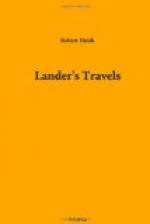CHAPTER XVIII.
The entry into Mourzouk, the capital of Sultan Mukni, was attended with the usual ceremonial. On drawing near to the palm groves and gardens, which encompass the city, a large body of horse and foot was seen approaching with silken flags. When the horsemen had advanced within five hundred yards of the party, they set off at full speed, and, on coming up, threw themselves from their horses, and ran to kiss the sultan’s hand. On drawing nearer to the town, the cavalcade was met by the dancers, drummers, and pipers. Two men, bearing fans of ostrich feathers, stationed themselves on each side of the sultan, beating off the flies. Thus preceded by the led horses and silken flags, they made their entry, the horsemen continuing to skirmish till they reached the gate. The soldiers then raced up every broad street, shouting and firing, whilst the women uttered their shrill cry, and on passing a large open space, a salute was fired from two six-pounders. The scene was altogether highly interesting.
Mourzouk is a walled town, containing about 2,500 inhabitants, who are blacks, and who do not, like the Arabs, change their residence. The walls are of mud, having round buttresses, with loopholes for musketry, rudely built, but sufficiently strong to guard against attack; they are about fifteen feet in height, and at the bottom eight feet in thickness, tapering, as all the walls in this country do, towards the top. The town has seven gates, four of which are built up, in order to prevent the people escaping when they are required to pay their duties. A man is appointed by the sultan to attend each of these gates, day and night, lest any slaves or merchandise should be smuggled into the town. The people, in building the walls and houses, fabricate a good substitute for stones, which are not to be found in those parts, by forming clay into balls, which they dry in the sun, and use with mud as mortar; the walls are thus made very strong, and as rain is unknown, durable also. The houses, with very few exceptions, are of one story, and those of the poorer sort, receive all their light from the doors. They are so low as to require stooping nearly double to enter them; but the large houses have a capacious outer door, which is sufficiently well contrived, considering




